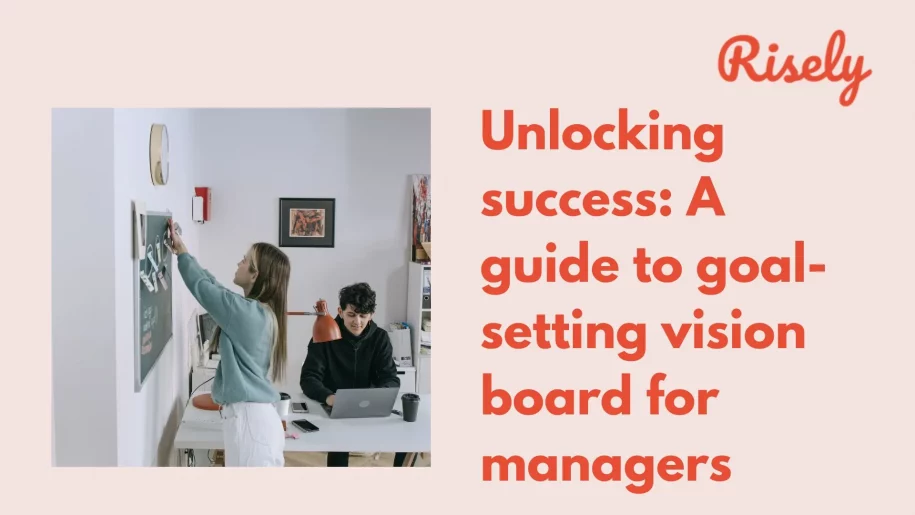Unlocking success: A guide to goal-setting vision board for managers
In today’s fast-paced business world, it can be difficult for managers to focus on their goals and aspirations. This is where a goal-setting vision board can be a powerful tool for success. A vision board is a visual representation of your goals and aspirations, and it can be used to clarify your vision, stay motivated, and inspire your team. In this blog, we’ll explore the benefits of vision boards for managers, including how to create a successful vision board, tips for overcoming common challenges, and how to use your vision board to achieve your goals. Whether you’re a manager for a long time or just starting, a vision board can be a valuable tool for staying focused and motivated on your journey toward success. So let’s explore the world of vision boards for managers!- Unlocking success: A guide to goal-setting vision board for managers
- What is a vision board?
- How does visualization work?
- Purpose of a goal-setting vision board
- Why are goal-setting vision boards effective?
- How can a manager create a goal-setting vision board?
- How to overcome goal-setting vision board challenges?
- Tips for a successful goal-setting vision board for managers
- Conclusion
- Other Related Blogs
What is a vision board?
A vision board is a tool for visualization and manifestation that typically consists of a collection of images, words, and other visual representations of what a manager wants to achieve, experience, or attract into their life. The idea is that by creating a physical representation of their goals and desires, they can activate the power of the law of attraction and help themselves focus on what they want rather than what they do not wish. The goal-setting vision board is made to create a visual representation that resonates with them and captures the essence of their goals and aspirations. The vision board should be placed in a prominent location where managers can see it often, such as on a wall in the office; this will help managers keep their goals and desires on top of mind and to provide daily inspiration and motivation.How does visualization work?
Visualization, also known as mental imagery or mental rehearsal, is a technique that involves using your imagination to create or recreate sensory experiences in your mind. It works by engaging the same neural networks and brain regions activated when you experience something in real life. When you visualize something, your brain sends signals to your nervous system, responding as if you are actually experiencing what you are imagining. Visualization can be used for various purposes, such as improving performance, reducing stress and anxiety, increasing motivation and confidence, and achieving goals. By repeatedly visualizing a desired outcome, you can train your brain to recognize and focus on the opportunities and resources that will help you achieve that outcome and to filter out distractions and obstacles that may get in your way.OtherInterestingReads
Purpose of a goal-setting vision board
A goal-setting vision board can be a valuable tool for managers to help clarify and focus their goals and to inspire and motivate themselves and their team. Here are some specific purposes a vision board can serve for managers:- Goal-setting: A vision board can help managers clarify their long-term and short-term goals and identify the steps they need to take to achieve them. By visualizing their goals, managers can more easily track their progress and stay on track.
- Team-building: A vision board can be a helpful tool, allowing team members to collaborate and share their visions for the future. By creating a collective vision board, managers can help their team members feel more invested in the team’s mission and goals and inspire them to work together towards a shared vision.
- Inspiration and motivation: A goal-setting vision board can serve as a daily reminder of what managers are working towards and provide them with inspiration and motivation to stay focused and productive. By regularly visualizing their goals and aspirations, managers can maintain a positive mindset and stay motivated even when faced with challenges or setbacks.
- Decision-making: A vision board can help managers make better decisions by giving them a clear sense of what they are working towards and helping them prioritize their goals and tasks. By regularly reviewing their vision board, managers can ensure that their decisions align with their long-term goals and vision.
Why are goal-setting vision boards effective?
There are several reasons why goal-setting vision boards can be effective:- Visualization: Visualization is a powerful technique that has been shown to activate the same neural pathways in the brain as actually experiencing something. By regularly visualizing their goals and aspirations, individuals can strengthen the neural pathways associated with those goals, making achieving them easier.
- Focus: A vision board helps individuals focus on their goals and desires. Regularly viewing their vision board reminds individuals of what they are working towards, and they are less likely to get distracted by other things.
- Motivation: Seeing a visual representation of their goals can be a powerful motivator for individuals. It can help them stay committed to their goals, even when faced with challenges or setbacks.
- Clarity: A goal-setting vision board can help individuals clarify their goals and aspirations. By creating a visual representation of what they want, individuals can better understand their priorities and more easily identify the steps they need to take to achieve their goals.
- Inspiration: A vision board can be a source of inspiration for individuals. It can help them stay connected to their vision and inspire them to take action toward their goals.
How can a manager create a goal-setting vision board?
- Define your goals: Start by defining your long-term and short-term goals. Consider what you want to achieve personally and professionally, and be specific. Next, write down your goals in a notebook or on paper.
- Gather materials: Collect materials for your vision board, such as magazines, newspapers, images from the internet, markers, glue, and a poster board or corkboard. Choose materials that resonate with your goals and aspirations.
- Visualize your goals: Spend some time visualizing your goals in your mind. Imagine what it would feel like to achieve your goals and your life as a result.
- Create your vision board: Use the materials you’ve gathered to create your vision board. Cut out images and words that represent your goals and aspirations, and arrange them on the board. Use colors and patterns that inspire you.
- Display your vision board: Once you’ve created it, display it in a place where you’ll see it every day. This could be in your office or on your phone or computer desktop. Ensure it’s somewhere you can easily access and refer to whenever you need inspiration or motivation.
- Review and update your vision board: Regularly review and update it as your goals and aspirations evolve. Add new images or words that resonate with your vision, and remove anything that no longer feels relevant.
How to overcome goal-setting vision board challenges?
- Lack of clarity: If you need help clarifying your goals, reflect on your values, interests, and aspirations. Consider working with a coach or mentor who can help you gain clarity and focus.
- Difficulty staying motivated: Creating a vision board is just the first step. To stay motivated, you need to take action toward your goals. Consider breaking your goals into smaller, more manageable tasks, and celebrate your progress.
- Negative self-talk: If you struggle with negative self-talk, try reframing your thoughts more positively. Focus on your strengths and accomplishments, and use affirmations to reinforce positive beliefs about yourself and your abilities.
- Lack of accountability: Consider sharing your vision board with someone you trust, such as a coach, mentor, or colleague. This can help create a sense of accountability and motivation to focus on your goals.
Tips for a successful goal-setting vision board for managers
- Be specific: When creating your goal-setting vision board, be clear about your goals and aspirations as possible. The more specific you are, the easier it will be to visualize and achieve your goals.
- Use visual cues: Use images, quotes, and other visual cues that inspire and motivate you. Choose pictures and words that resonate with your goals and aspirations and evoke positive emotions.
- Focus on the present: Visualize your goals as they have already been achieved. Use present tense statements and images to reinforce the idea that your goals are within reach.
- Keep it simple: Don’t overcrowd your vision board with too many images or words. Instead, keep it simple and focused, with just a few key messages that represent your goals and aspirations.
- Review it regularly: Review your vision board regularly, preferably daily. Use it as a reminder of your goals and aspirations and as a source of motivation and inspiration.
- Take action: A vision board is just a tool to help you visualize your goals. To achieve those goals, you need to take action. Use your vision board as a guide to help you plan and prioritize your actions.
Conclusion
A goal-setting vision board can be a powerful tool for managers looking to clarify their goals, stay motivated, and inspire their team. By visualizing your goals and aspirations, you can focus on what’s truly important and work towards achieving your objectives with greater clarity and purpose. Remember to stay specific and use visual cues that inspire and motivate you. Keep your vision board focused and straightforward, and review it regularly to stay on track. Feel free to share your vision board with others to create a shared vision and inspire your team to work towards a common goal. Finally, remember that a vision board is just a tool to help you visualize your goals. To achieve those goals, you need to take action. Use your vision board as a guide to help you plan and prioritize your actions and celebrate your progress. With these tips in mind, you can create a powerful visualization tool to help you succeed as a manager.Are you headed in the right direction?
Learn more about your goal-setting skills with a quick free assessment
Other Related Blogs
Are you on track to meet your Q1 goals?
Are you on track to meet your Q1 goals? We are in the middle of the first quarter of 2024. Seems hard to believe. It surely is! ⏰ Time has…
5 Secrets Of Solid Goal Setting At Work You Can’t Miss
5 Secrets Of Solid Goal Setting At Work You Can’t Miss “I don’t focus on what I’m up against. I focus on my goals and I try to ignore the…
Understanding the world of Goal Setting Coach to reach new heights
Understanding the world of Goal Setting Coach to reach new heights Setting and achieving goals is essential for personal and organizational success in today’s fast-paced and competitive work environment. However,…
Master Collaborative Goal-Setting for Effective Team Management (with examples)
Master Collaborative Goal-Setting for Effective Team Management (with examples) Collaborative goal-setting is an essential process that enables teams to work together towards a common objective. It involves creating shared goals…


